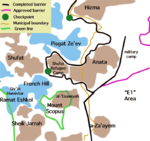Kfar Devora

Kfar Dvora was a Jewish settlement during the Talmudic period in the upper Gilbon River in the Golan Heights. At the site, remains of a Jewish settlement, synagogue, a Beth midrash, 5 inscriptions in Aramaic, 1 in Greek, and one in Hebrew were discovered, which was a novelty in research, as it indicated the existence of a Beth midrash in the place. Many decorated stones were also found, integrated into secondary construction and scattered in the area. On the ruins of Kfar Dvora, the Syrian village of Daburiya was established, which is currently abandoned. Before the Six-Day War, the village was inhabited by Bedouins of the Na'arna tribe, who made secondary use of the stones from the ancient Jewish settlement for construction purposes. The village is currently located northwest of the settlement of kidmat Tzvi.
Excerpt from the Wikipedia article Kfar Devora (License: CC BY-SA 3.0, Authors, Images).Kfar Devora
4371,
Geographical coordinates (GPS) Address Nearby Places Show on map
Geographical coordinates (GPS)
| Latitude | Longitude |
|---|---|
| N 31.82375 ° | E 35.274555555556 ° |
Address
مقبرة أطفال
4371
Judea and Samaria, Palestinian Territories
Open on Google Maps






